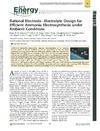Identificador persistente para citar o vincular este elemento:
https://accedacris.ulpgc.es/jspui/handle/10553/74925
| Título: | Rational Electrode–Electrolyte Design for Efficient Ammonia Electrosynthesis under Ambient Conditions | Autores/as: | Suryanto, Bryan H. R. Kang, Colin S. M. Wang, Dabin Xiao, Changlong Zhou, Fengling Azofra Mesa, Luis Miguel Cavallo, Luigi Zhang, Xinyi MacFarlane, Douglas R. |
Clasificación UNESCO: | 2210 Química física | Fecha de publicación: | 2018 | Publicación seriada: | ACS Energy Letters | Resumen: | Renewable energy-driven ammonia electrosynthesis by N2 reduction reaction (NRR) at ambient conditions is vital for sustainability of both the global population and energy demand. However, NRR under ambient conditions to date has been plagued with a low yield rate and selectivity (<10%) due to the more favorable hydrogen evolution reaction (HER) in aqueous media. Herein, surface area enhanced α-Fe nanorods grown on carbon fiber paper were used as NRR cathodes in an aprotic fluorinated solvent–ionic liquid mixture. Through this design, significantly enhanced NRR activity with an NH3 yield rate of ∼2.35 × 10–11 mol s–1 cmGSA–2, (3.71 × 10–13 mol s–1 cmECSA–2) and selectivity of ∼32% has been achieved under ambient conditions. This study reveals that the use of hydrophobic fluorinated aprotic electrolyte effectively limits the availability of protons and thus suppresses the competing HER. Therefore, electrode–electrolyte engineering is essential in advancing the NH3 electrosynthesis technology. | URI: | https://accedacris.ulpgc.es/handle/10553/74925 | ISSN: | 2380-8195 | DOI: | 10.1021/acsenergylett.8b00487 | Fuente: | ACS Energy Letters [ISSN 2380-8195], v. 3, 6, p. 1219–1224 |
| Colección: | Artículos |
Citas de WEB OF SCIENCETM
Citations
215
actualizado el 08-jun-2025
Visitas
69
actualizado el 02-mar-2024
Descargas
102
actualizado el 02-mar-2024
Google ScholarTM
Verifica
Altmetric
Comparte
Exporta metadatos
Los elementos en ULPGC accedaCRIS están protegidos por derechos de autor con todos los derechos reservados, a menos que se indique lo contrario.
